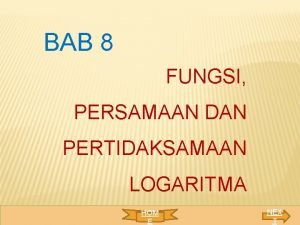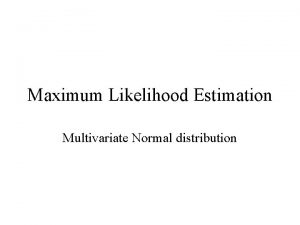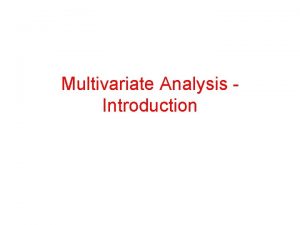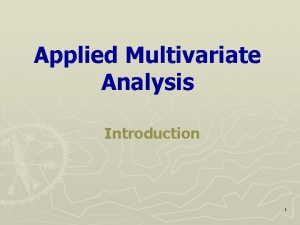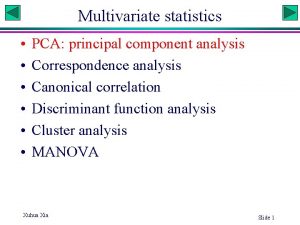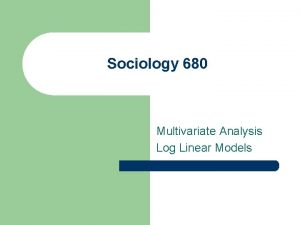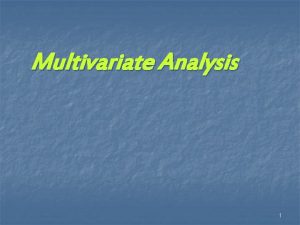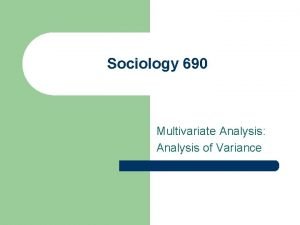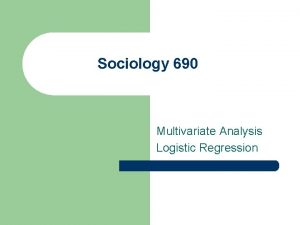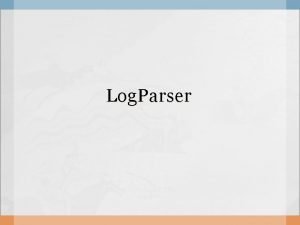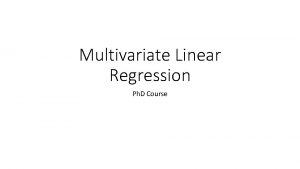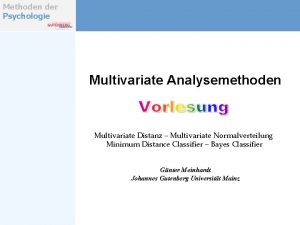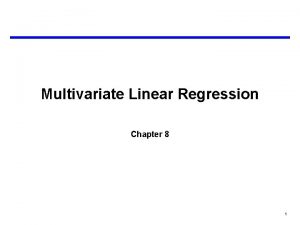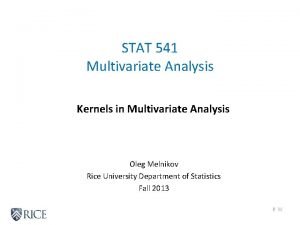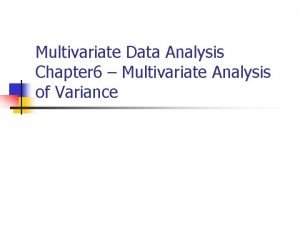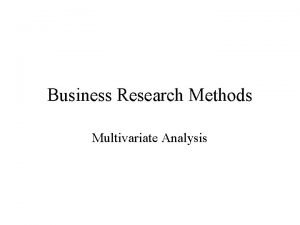Sociology 690 Multivariate Analysis Log Linear Models The














- Slides: 14

Sociology 690 Multivariate Analysis Log Linear Models

The Analysis of Categories IV Category Quantity 1) Analysis of Variance Models (ANOVA) 2) Structural Equation Models (SEM) Linear Models Category 3) Log Linear Models (LLM) 4) Logistic Regression Models (LRM) Category Models DV

Cross-classification l Ironically, while categorical data are among the most prevalent form of information collected in sociology, until recently the most dominant types of statistical analysis have been based on continuous data: e. g. t-tests, ANOVA, correlation, regression—in short the general linear model.

Typical Goodness of Fit Model l The analysis of effects among categorical variables has been traditionally accomplished through cross-tabulation tables, utilizing a “goodness of fit” method such as chi square. l To the extent the observed frequencies deviate from expected cell frequencies, we would reject the assumption that the variables are independent and accept the alternative that they are related.

Example of Chi Square Suppose we have the following cross-classification of observed frequencies for two categorical variables: Chi Square would be determined by the following formula: Attend College Sex Yes No Total Female Male 40 10 50 35 65 100 75 75 150 Total Where the expected frequencies are determined by the formula (fc x fr) / ft

Chi Square Calculation: Sex Female Male Total Attend College Yes No 40 35 10 65 50 100 Total 75 75 150 Here chi square would be calculated as follows: (25 -40)2/25 + (50 -35)2/50 + (25 -10)2/25 + (50 -65)2/50 = 9+4. 5+9+4. 5 = 27. With 1 d. f. (r-1 x c-1) Significance And the measure of association would be derived from chi square (e. g. )

What chi square does not cover l But what if we wanted to examine more than two categorical variables (as in a 2 x 2 crossclassification table). l This kind of multi-way frequency analysis (sometimes called MFA) could be done by calculating chi-squares on all the possible two-way tables. l However, that would (among other things), prevent us from calculations of any interactions between the variables.

Purpose of Log Linear Analysis l Log-linear models are typically used with multi-way dichotomous or categorical variables. They focus on a procedure for accounting for the distribution of cases in a cross-tabulation of categorical variables. l Based on the association of categorical data (rather than the causal sequencing of independent and dependent variables), LLA looks at all levels of possible interaction effects. In this sense, Log-linear analysis is a type of multi-way frequency analysis (MFA) and sometimes loglinear analysis is labeled MFA.

Definitions in Log linear Analysis l Ln(Fij) = + i. A + j. B + ij. AB, where: l Ln(Fij) = is the log of the expected cell frequency of the cases for cell ij in the contingency table. l = is the overall mean of the natural log of the expected frequencies l = terms each represent “effects” which the variables have on the cell frequencies l A and B = the variables l i and j = refer to the categories within the variables

Procedure for Log Linear Analysis l Choosing the model l Fitting the model l Estimating the Parameters l Testing the Goodness of Fit

Choosing the Model l Saturated vs. Unsaturated If all possible effects are included in the model, is it considered saturated. Unsaturated models are useful when the number of effects equals the number of cell (as would be the case in a 2 x 2 table). l Hierarchical vs. Non-Hierarchical The former implies that if we have a higher interaction effect in our model (e. g. Ax. BXC), we must include a lower interaction effect (e. g. Ax. B)

Estimating Parameters Sex Female Male Total Attend College Yes No 40 35 10 65 50 100 Total 75 75 150 Odds and Odds Ratios: In our original cross-tabulation table, the odds of being female is 75/75 or 1. 0. The odds of being in college is 40/10 or 4. 0 and the odds of no being in college are 35/65 or. 54. An odds ratio is the conditional odds of one category divided by the conditional odds of the other category. Hence the odds ratio for women being in college is 4. 0/. 54 or 7. 55. Odds ratios greater than one = a relationship.

SPSS Input

SPSS Output
 Jika log 5 = 0 699 nilai log 20 adalah
Jika log 5 = 0 699 nilai log 20 adalah Nilai dari 2 log 84
Nilai dari 2 log 84 5 log 50 - 5 log 2
5 log 50 - 5 log 2 Jika diketahui log 2
Jika diketahui log 2 Jika log 2 = 0 301 nilai log 32 =
Jika log 2 = 0 301 nilai log 32 = ³log 27 - ³log 81
³log 27 - ³log 81 Jika panjang ap 8 cm bq 5 cm
Jika panjang ap 8 cm bq 5 cm Fungsi persamaan dan pertidaksamaan logaritma
Fungsi persamaan dan pertidaksamaan logaritma Maximum likelihood
Maximum likelihood What is multivariate
What is multivariate Analysis of variance
Analysis of variance Nature of multivariate analysis
Nature of multivariate analysis Multivariate analysis of variance and covariance
Multivariate analysis of variance and covariance Multivariate analysis
Multivariate analysis Multivariate statistical analysis
Multivariate statistical analysis







